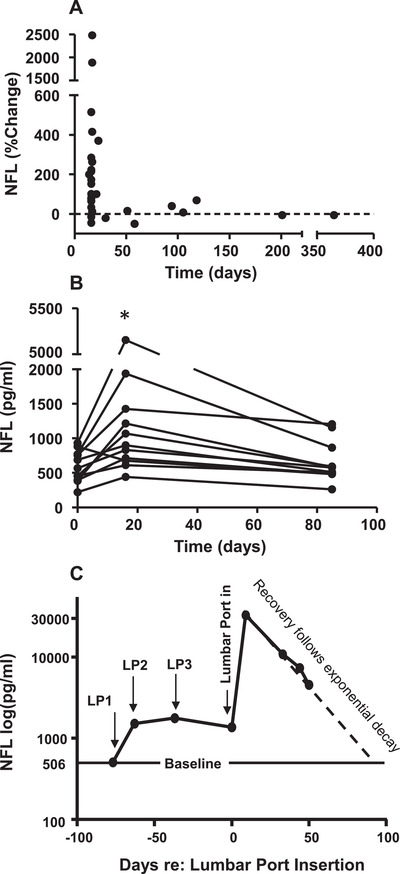FIGURE 2.

Timecourse of neurofilament light (NFL) elevation and decline after repeated lumbar punctures (LPs). A, The percent change in NFL from Figure 1E is plotted along with data from seven additional animals who had second LPs at longer delays, demonstrating that increases in NFL due to LP are not evident after 1 to 2 months delay. Values at 58, 118, 201, and 365 days of separation were obtained from animals under full isoflurane anesthetic via intubation, in addition to ketamine. B, Values of NFL are plotted from a subset of NHPs from Figure 1E (n = 11) who had a second LP after 16 days, and a third LP after another 69 days (85 days after original baseline). NFL concentrations were significantly elevated after 16 days (P < .03), and had decreased to near baseline levels after an additional 69 days. Most animals (8/11) had all LPs conducted under ketamine only. The others (3/11) received ketamine and masked isoflurane, with one under full anesthesia for LP2. C, In another animal, three LPs were performed (0, 14, and 26 days) and NFL was elevated after both the first and second LPs. Then, a lumbar port was implanted (requiring a fourth LP) to track the decline in NFL over time. NFL increased dramatically after lumbar port insertion, and then declined over 50 days after an exponential decay function (y = 50371e‐0.046x, R2 = 0.99) which predicted a return to baseline at 100 days. In addition to ketamine, this animal received brief masked isoflurane for LP1 and was under full isoflurane anesthetic via intubation for LP2 and lumbar port insertion. Samples after port insertion were taken with the animal awake in the home cage.
